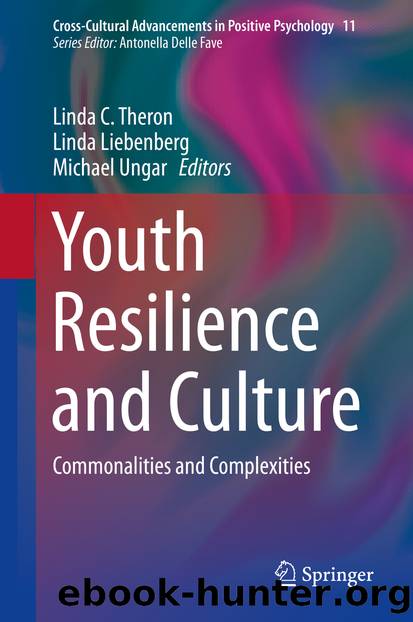Youth Resilience and Culture by Linda C. Theron Linda Liebenberg & Michael Ungar

Author:Linda C. Theron, Linda Liebenberg & Michael Ungar
Language: eng
Format: epub
Publisher: Springer Netherlands, Dordrecht
Reflecting on John’s narrative and how it relates to IQ, Ungar et al.’s (2007) seven tensions can provide a framework highlighting the resilience processes that surround him. The seven tensions include access to material resources; relationships; identity; power and control; cultural adherence; social justice; and cohesion. These tensions help to link John’s narrative back to the spiritual and cultural sub-clusters of questions in the CYRM-28. It is clear from John’s narrative that he balances adherence to global notions of success (staying in school, getting good grades, going to college, getting a good job and earning a good salary) with adherence to his local traditional Inuit values (supporting his family and broader community, making choices to be a good role model). His time is balanced between the attainment of these goals (by going to school) and engagement in the activities that sustain him (relationships and cultural engagement in activities such as hunting, and his commitment to learning his language). It is John’s adherence to Inuit culture, however, that forms the foundation of the resilience processes that surround him and therefore the degree to which he adheres to the more dominant global culture. Specifically, his long term vision (taking the long view) motivates John to access the material resources made available through school, education and employment by means of his resourcefulness. These resources become vehicles for his attainment of long term goals, goals that are embedded in his adherence to traditional culture and values.
John’s sense of trust in the relationships that surround him, combined with his willingness to share of himself with his community – to engage in the reciprocal teamwork that is required to ensure community cohesion – are reflective of his experience of social cohesion: he is part of a community that is larger than himself. Because of his integration and participation in family and community, where he has a role to play and something to contribute, John has the experience of social justice. His sense of cohesion and justice is related to his willingness to listen to and be respectful of those around him, adults and elders in particular. From these experiences, John also has a sense of responsibility to self and others. It is the interaction of these components, his access to relationships, his sense of cohesion and consequent access to resources, which characterise John’s traditional cultural adherence. Perhaps most importantly, it is also these components that contribute to John’s sense of power and control over his life and the choices he makes as well as his identity as an Inuit. John’s sense of identity is reflected in his sense of intergenerational purpose, his capacity for self-appraisal, and his connection to Inuit beliefs and values.
While John is seen to make important decisions with regards to his life, it is crucial to recognise that much of what informs John’s resilience processes and his personal outlook on life comes from others: his father took him hunting – John did not request this; Inuttitut lessons are provided at school, unasked for by John; teachers volunteer their support, help and advice, John did not have to actively seek this.
Download
This site does not store any files on its server. We only index and link to content provided by other sites. Please contact the content providers to delete copyright contents if any and email us, we'll remove relevant links or contents immediately.
Rewire Your Anxious Brain by Catherine M. Pittman(17589)
Talking to Strangers by Malcolm Gladwell(11877)
The Art of Thinking Clearly by Rolf Dobelli(8842)
Mindhunter: Inside the FBI's Elite Serial Crime Unit by John E. Douglas & Mark Olshaker(7834)
Becoming Supernatural by Dr. Joe Dispenza(7106)
Change Your Questions, Change Your Life by Marilee Adams(6641)
The Road Less Traveled by M. Scott Peck(6635)
Nudge - Improving Decisions about Health, Wealth, and Happiness by Thaler Sunstein(6633)
The Lost Art of Listening by Michael P. Nichols(6474)
Enlightenment Now: The Case for Reason, Science, Humanism, and Progress by Steven Pinker(6405)
Win Bigly by Scott Adams(6311)
Mastermind: How to Think Like Sherlock Holmes by Maria Konnikova(6236)
The Way of Zen by Alan W. Watts(5800)
Daring Greatly by Brene Brown(5641)
Grit by Angela Duckworth(4737)
Big Magic: Creative Living Beyond Fear by Elizabeth Gilbert(4723)
Men In Love by Nancy Friday(4323)
Flow by Mihaly Csikszentmihalyi(4052)
The Four Tendencies by Gretchen Rubin(4024)
